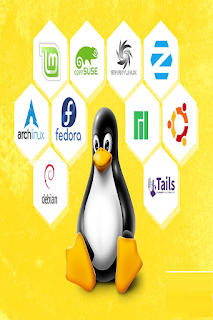The Best Uses of Linux in An Organization
Linux is an open-source operating system just like Windows and MacOS. It is not only limited to the operating system, but it is also used as a platform to run desktops, servers, and embedded systems. It provides various distributions and variations as it is open source and has a modular design. The term called Kernel is the core part of the Linux system.
Linux
system is also used to manage various services such as process scheduling,
application scheduling, basic peripheral devices, file system, and many more.
Linux provides various advantages over other operating systems such as Windows
and MacOS. Therefore, it is used in almost every field, from cars to home
appliances and smartphones to servers (supercomputers).
Why Linux is far more better than other operating
systems?
There are many features of the Linux
operating system which illustrates that it is better than other operating
systems. However, in some prospective, other operating systems can be more
useful than Linux.
Some of the advantages of Linux:
1. Pen Source
As it is an open-source, its source code is easily
available. Anyone who have programming knowledge can customize the operating
system by itself. One can easily contribute, modify, distribute, and enhance
the code for any purpose.
2. Security
The Linux
security feature is the main reason that it is the most favourable option for
the developers. Though it is not completely safe, but it is less vulnerable in
comparison to others. Each application needs to be authorized by the admin
user. The virus is not executed until the administrator provides the access
password. Linux systems does not require any antivirus program.
3. Free
Certainly, the biggest advantage of the Linux system is
that it is free for its users. Anyone can easily download it, and there is no
need to buy the license for it. It is distributed under GNU (an extensive
collection of free software) GPL (General Public License). As compared to other
operating systems, we have to pay a huge amount for the license of the other
operating systems.
4. Light in weight
Linux
is light in weight operating system. The requirements for running Linux
in the system are much less than the other operating systems. In
Linux, the memory footprint and disk space are also less. Generally, most
of the Linux
distributions required are as little as 128MB of RAM around the same amount for
disk space.
5. Stability
Linux
is much more stable than other operating systems. Linux
does not require to reboot the system to maintain its performance levels. It
rarely hangs up or slow down. It has such big up-times.
6. Performance
Linux
system provides high performance to all its users over different networks. It
is also capable of handling a large number of users simultaneously.
7. Flexibility
Linux
operating system is a flexible operating system. It can be used for desktop
applications, embedded systems, and server applications too. It also provides
various restrictions for specific computers. We can install only necessary
components for a system.
8. Software Updates
In Linux,
the software updates are under user control. We can also select the required
updates. There are a large number of system updates available. These updates
are much faster in comparison to the other operating systems. So, the system
updates can be installed easily without facing any issue.
9. Distributions
There are a wide variety of Linux distributions available
in the market. It provides various options and flavours of Linux
to all its users. We can choose any available distros according to our needs.
Some popular distros are Ubuntu, Fedora, Debian, Linux Mint, Arch Linux, and
many more.
For the beginners, Ubuntu and Linux Mint would be useful
and, Debian and Fedora would be good choices for proficient programmers.
10. Live CD/USB
Almost all Linux
distributions have a Live CD/USB option. It allows the users to try or run the Linux
operating system without installing it.
11. Graphical User Interface
Linux
is a command-line based Operating System but, it provides an interactive user
interface like Windows.
12. Suitable for programmers
It supports almost all of the mostly used programming
languages such as C/C++, Java, Python, Ruby, and more. Further, it offers a wide
range of useful applications for the development.
The programmers prefer the Linux
terminal over the Windows command line. The package manager on Linux
system helps the programmers to understand how things are done. Bash
scripting is also a functional feature for the programmers. It also provides
support for SSH (also known as Secure Shell), which helps in managing the
servers quickly.
13. Community Support
Linux
provides large community support. We can find support from various sources.
There are many forums available on the web to assist the users. Further,
developers from the various open source communities are ready to help us.
14. Privacy
Linux
always takes care of user privacy as it never takes much private data from the
user. In comparison to other operating systems ask for the user's private data.
15. Networking
Linux
facilitated with the most powerful support for networking. The client-server
systems can be easily set to a Linux system. It provides various command-line
tools such as ssh, ip, mail, telnet, and more for the connectivity with the other
systems and servers. Tasks such as network backup are much faster than others.
16. Compatibility
Linux
is more compatible with an outsized number of file formats because it supports
most file formats available.
17. Installation
Linux
installation process takes less time than the opposite operating systems like Windows.
Further, its installation process is far easy because it requires less user
input. It doesn't require far more system configuration even it are often
easily installed on old machines having less configuration.
18. Multiple Desk Support
Linux
system also provides multiple desktop environment support for its enhanced
use. The desktop environment option are often selected during the installation
process. We can select any desktop environment like GNOME (GNU Network Object
Model Environment) or KDE (K Desktop Environment) as both have their specific
environment.
19. Multitasking
Linux
may be a multitasking OS because it can run multiple tasks simultaneously
without affecting the speed of the system.
20. Heavily Documented for beginners
There are several command-line options that provide
documentation on commands, libraries, and standards like manual pages and info
pages. Also, there are many documents available on the web in several formats,
like Linux tutorials, Linux documentation project, Serverfault, and more. To
help the beginners, several communities are available like Ask Ubuntu, Reddit,
and StackOverflow.
Red Hat Certified System Administrator (RHCSA) Training
lays a foundation for becoming Linux System Administrator. This training
introduces command line concepts and explains essential tools for handling
files and system administration. The training takes you deeper into
administering and troubleshooting file system, partitioning, logical volume
management, access control, and security.
Brillica Services provides the Best Project based
Internship on Red Hat Certified System Administrator Training Course in Delhi
and Dehradun, Uttarakhand.
Follow for more: https://www.brillicaservices.com/


Comments
Post a Comment